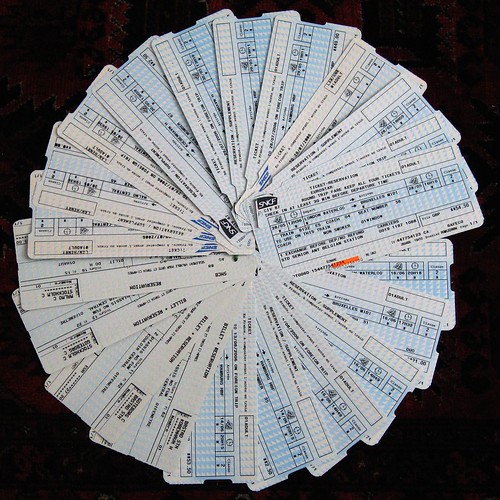The railways in the Republic of Ireland have for decades kept going with a fleet of rolling stock, mostly locomotive-hauled, composed of a mixture of vehicles ancient and modern. This demonstrates good housekeeping. Major acquisitions were the so-called "Cravens" in the early 1960s, 80 British Rail mark 2 coaches in the 1970s, 132 British Rail mark 3 coaches of British Rail design at the end of the 1980s, and 14 vehicles based on the Eurostar for the Dublin-Belfast service. Then came the 67 mark 4 coaches built by CAF, which entered service on the Dublin-Cork route from 2006.
One might have expected that the replacement and renewal programme in Ireland would have gone at about the same rate as in Britain or elsewhere, with the mark 3 fleet running for at least another 30 years. But then came a huge investment under the Irish Government's Transport 21 Plan, with all the mark 3 fleet being replaced by a large fleet of diesel multiple unit trains for both inter-city and commuter services. The mark 3 stock is now stored ready for scrapping.
The cost of the DMUs is given at just over €2.3 per vehicle, which means that over £250 million has been spent on replacing the mark 3 stock prematurely. The weight of these DMUs is given as an unbelievable 63 tons per vehicle, which must surely be an error since a tilting Voyager is 52 tons and an HST power car weights 70 tons.
What would it have cost to refurbish the stock and purchase a fleet of new diesel-electric locomotives? Allowing a generous £200,000 per vehicle for the refurbishment and £70 million for the purchase of, say, 30 locomotives, a total of just under £100 million, it still sounds as if this modernisation has cost 2.5 times what it needed to have done. If other forms of modern traction had been considered, the cost might have been as low as £60 million. If the weight of these DMU cars really is 63 tons, then these trains are going to use a lot of fuel and wear out a lot of track.
This scheme was of course put in place in when Irish Republic's illusory boom seemed as if it would continue for ever. It now looks like profligacy. If times had been otherwise, prudence would still have ruled. However, with the money gone as a result of the choice of priorities , what has been lost is the opportunity to re-connect large areas of the country to the railway system, including the proposed West Coast Rail Corridor, now stalled.
Nor is that the end of the story. Given the shortage of stock in Britain, one might have thought that someone would have looked seriously into the prospect of acquiring the fleet. Obviously there would have been costs involved in re-gauging, refurbishing and dealing with compatibility problems, but it is hard to believe that these would have been bad value compared with new build.
25 Jan 2010
23 Jan 2010
Mark 3 stock and its derivatives
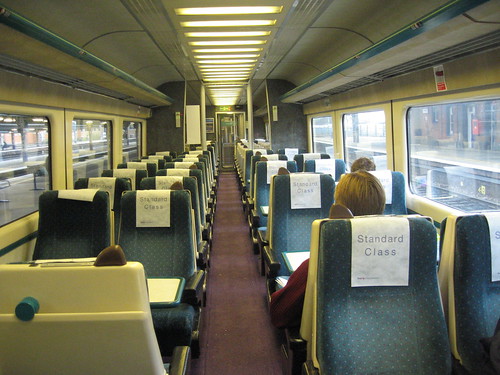
Most people who have travelled on trains in Britain will be familiar with British Rail's Mark 3 stock as these are the carriages in an Inter City 125 train. They have served the railways well and proved a remarkably good investment. The first came into service in 1972 and over 800 were built for service in the UK and a further 120 for the railways of the Irish Republic before production ceased around 1990. In addition, the design was the basis of many types of electric multiple unit trains as well as the International train illustrated in the masthead of this blog, a commercial venture by British Rail Engineering Ltd.
It is well described in the Wikipedia entry but there is more to be said. The 23 metre long bodyshell is a steel monocoque structure, with reinforcing top-hat sections welded on to 3 mm sheet steel. The horizontal members are welded direct to the sheet steel shell and the vertical ones are joggled to fit over the horizontals. There are substantial box section reinforcement members at floor level. The roof is composed of corrugated sheet steel with reinforcing steel diaphragms. Thus the structure is essentially an inverted-U section. This bodyshell construction combines strength with light weight and has not been improved upon.
At the time they were introduced, the mark 3 vehicles were 3 metres longer than anything else running in Britain. The extra length was accommodated by reducing the external width from the maximum permitted, 2.82 metres, to 2.74 metres. There was no loss in space because the reduction was achieved by eliminating or recessing projections such as door handles, though some alterations to the infrastructure were still needed.
Whilst this was an advanced design for 1972, shortcomings became apparent. The need to joggle the vertical top hat sections was time-consuming in the manufacturing process. This might have been avoided if corrugated sheets had been used for the bodyside, as in these Swedish vehicles built around the same time.

The suburban multiple unit versions were prone to corrosion of the floor and lower bodyside, where large amounts of rusty water could collect. This was possibly due to the lack of air conditioning, leading to condensation, as the inter-city vehicles are hardly affected by corrosion apart from the floors in the toilets.
From the passengers' point of view, mark 3 stock suffers from niggling features. The wrap-round doors are heavy, awkward and eventually had to be fitted with secondary locking, following a series of fatalities. Very few of the vehicles were fitted with power operated doors. The window cills are too high, especially for small children who cannot see out of the train. The bay dimension of 2.1 metres, with eight bays per vehicle, is based on the spacing of first class seats and consequently the more closely spaced seats in the standard class vehicles are misaligned to the windows. A "window" seat may or may not have a window alongside. The seat reservation system does not have this information and some passengers end up with no view out of the train. These issues were addressed with the International train, which had power operated doors and a bay dimension of, probably, 1.90 metres, giving an extra seating bay in each vehicle. This is exactly right if the aim is to optimise capacity and comfort, and was adopted for the Alstom's Adelante diesel train.
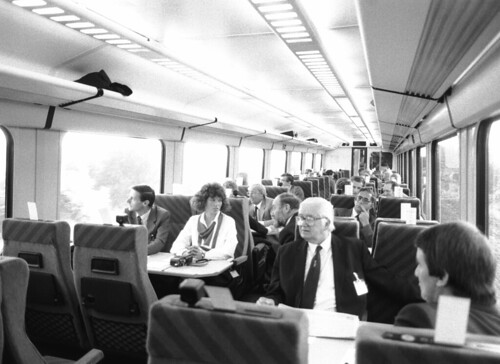
However, it is possible to fit 64 seats into a mark 3 vehicle, with all being fully aligned to the bays, plus four seats with no view. The International allows 72 aligned seats (above). In recent refurbishments, some mark 3 vehicles have been fitted with fully aligned seats and have been widely praised, whereas in others, notoriously, First Great Western, as many seats as possible have been crammed into standard class and the result is described as grim.
The future of the mark 3 fleet
Replacements for the Mark 3 stock have now been ordered, in the shape of the Hitachi Super Express train, specified by the Department of Transport. This seems set to be one of the worst investments in the history of Britain's railways, but it will be the subject of other blogs.DfT takes the view that Mark 3 stock is showing its age. That is a meaningless statement. Rail vehicles are like houses, with systems and components that wear out and become obsolescent at different rates. A few components may last longer than the vehicles themselves and should be recovered and re-used. Basic good housekeeping should apply. One does not demolish one’s house because it needs repainting. The main structure of a steel monocoque railway vehicle such as a mark 3 can reasonably be expected to last for 60 years, which means they should continue in service for another 20 or 30 years. The use of old stock is an important means by which the burden of fixed capital costs can be kept down. So far as the passenger environment is concerned, there is little or no perceptible difference between an old vehicle and a new one, since it is comfort, space and presentation that are noticed. There are certain issues with the mark 3 fleet but their life expectancy is sufficient to be worth addressing them.
There is also the matter of the fleet now being disposed of from the Irish Railway system. So far as I am aware, little serious study was done regarding the issue of gauge conversion of these vehicles, which are actually newer than the British fleet, have power-operated doors and would have been a useful and relatively inexpensive addition to the railway’s resources. The DfT appears to have missed another trick here.
DfT argues that re-use of mark 3 fleet will not have the capacity for growth, but the exact opposite is the truth: its retention and augmentation with new compatible vehicles, plus, possibly the Irish fleet, would seem to offer the best possible means of increasing capacity.
Future developments
The mark 3 concept has come to an undeserved dead-end. The International configuration with larger and more closely spaced windows was an excellent one, offering passengers a much improved ambience. Corrugated sheet structures are a sound and well established means of adding strength and stiffness without adding to weight. Stainless steels are now more readily available in suitable grades and their use should lead to greater longevity and reduced maintenance costs. A fleet of vehicles designed on these principles, locomotive-hauled and compatible with the existing mark 3 fleet, would provide enhanced capacity and future flexibility. It would probably look something like this. The DfT should be made to review this matter as soon as possible after the election.
20 Jan 2010
Energy conversion on the railway
Sometimes it is worth considering first principles. All transport systems require the conversion of chemical or atomic or potential energy into mechanical energy. The preferred method of doing this is to carry out the initial conversion at a central location such as a power station. This has been realised since almost the beginning of railways, first with the use of rope traction, then with the atmospheric railways in the 1840s, and eventually with the development of electric traction.
But electric traction means that the railway must be provided with a fixed supply of electricity, usually in the form of an overhead contact cable or conductor rail. This is a mature technology and the preferred option where traffic densities are high and the cost of installation can be justified. On routes where traffic volumes are low, the conversion of chemical energy to mechanical energy must take place in a prime-mover vehicle of some kind. The chemical energy can be converted into electrical energy and stored temporarily in batteries but the energy density is low, though the technology improves all the time. The most energy-dense substances at normal temperatures are hydrocarbons with about 8 carbon atoms per molecule, which is why they are the most desirable of fuels. Biomass in its various forms is of low energy density and large volumes are needed.
Internal and external combustion
Hydrocarbon fuels can conveniently be converted into mechanical energy in an internal combustion machine. In smaller sizes these are mass produced and inexpensive and have the advantage of being compact. Internal combustion gives high efficiency of conversion but the rate of combustion of the fuel must at all times precisely match the output of mechanical power, consequently the machine must be sized for the maximum output. Hybrid devices are possible in which the mismatch between the rate of conversion of chemical energy and the power requirement is evened-out through the use of an energy storage system such as a flywheel or electric battery. Internal combustion machines have a few inherent disadvantages. The fuel must be carefully formulated. They are inherently noisy and give rise to vibration. Combustion is incomplete and results in the production of undesirable products such as particulates and nitrogen oxides. They have low power and low torque when running at low speeds, which means that a power transmission system is needed, adding complexity and reducing efficiency. Larger internal combustion machines are difficult to start, and consequently tend to be left running when not actually in use.
External combustion machines separate the combustion process through the introduction of an intermediate stage in which energy is stored until required for use, usually in the form of a hot compressed gas. This enables better control of the combustion process, with the fuel being fully oxidised, thereby preventing the emission of particulates. The combustion system can be sized to match the energy output requirement, averaged out over an appropriate period. The conversion of heat to mechanical energy then takes place in a separate device, and only this needs to be sized for maximum output. Such machines typically deliver high torque at low speeds, and no transmission system is needed, significantly reducing initial costs, transmission losses and maintenance requirements. In theory, any material that will burn can be used as fuel.
At any point in time, circumstances and the state of the technology will affect the relative advantages of the different options. When investment decisions are being made, it is essential to evaluate all the possibilities.
But electric traction means that the railway must be provided with a fixed supply of electricity, usually in the form of an overhead contact cable or conductor rail. This is a mature technology and the preferred option where traffic densities are high and the cost of installation can be justified. On routes where traffic volumes are low, the conversion of chemical energy to mechanical energy must take place in a prime-mover vehicle of some kind. The chemical energy can be converted into electrical energy and stored temporarily in batteries but the energy density is low, though the technology improves all the time. The most energy-dense substances at normal temperatures are hydrocarbons with about 8 carbon atoms per molecule, which is why they are the most desirable of fuels. Biomass in its various forms is of low energy density and large volumes are needed.
Internal and external combustion
Hydrocarbon fuels can conveniently be converted into mechanical energy in an internal combustion machine. In smaller sizes these are mass produced and inexpensive and have the advantage of being compact. Internal combustion gives high efficiency of conversion but the rate of combustion of the fuel must at all times precisely match the output of mechanical power, consequently the machine must be sized for the maximum output. Hybrid devices are possible in which the mismatch between the rate of conversion of chemical energy and the power requirement is evened-out through the use of an energy storage system such as a flywheel or electric battery. Internal combustion machines have a few inherent disadvantages. The fuel must be carefully formulated. They are inherently noisy and give rise to vibration. Combustion is incomplete and results in the production of undesirable products such as particulates and nitrogen oxides. They have low power and low torque when running at low speeds, which means that a power transmission system is needed, adding complexity and reducing efficiency. Larger internal combustion machines are difficult to start, and consequently tend to be left running when not actually in use.
External combustion machines separate the combustion process through the introduction of an intermediate stage in which energy is stored until required for use, usually in the form of a hot compressed gas. This enables better control of the combustion process, with the fuel being fully oxidised, thereby preventing the emission of particulates. The combustion system can be sized to match the energy output requirement, averaged out over an appropriate period. The conversion of heat to mechanical energy then takes place in a separate device, and only this needs to be sized for maximum output. Such machines typically deliver high torque at low speeds, and no transmission system is needed, significantly reducing initial costs, transmission losses and maintenance requirements. In theory, any material that will burn can be used as fuel.
At any point in time, circumstances and the state of the technology will affect the relative advantages of the different options. When investment decisions are being made, it is essential to evaluate all the possibilities.
19 Jan 2010
Eurostar as it ought to be
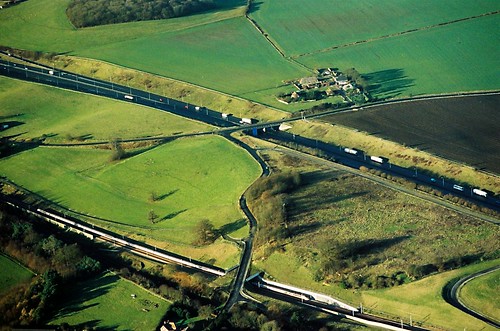
In this photograph, a Eurostar train is about to enter the Channel Tunnel. When Eurostar began running in 1996, a new terminal was built at Ashford and many trains called there. This was not particularly useful as connections from Ashford are poor, and when the St Pancras terminal was opened in 2007, the revised timetable cut down the number of trains that stopped at Ashford, so most Eurostar passengers go through London.
But what if Ashford was developed as a hub? If connecting lines were improved, trains could run direct to Brighton, Reading and Peterborough via Cambridge. Many more passengers would then be able to catch a Eurostar service without going in to central London, and an hourly trains to Paris and Brussels would pick up a worthwhile volume of traffic at Ashford.
But that is not all. Train services fanning out from Ashford would provide useful travel opportunities for everyone living in the South-East - not just Eurostar passengers, since they would give good connections between many important centres within the regiion.
Britain's spare main lines
One of the reasons given for building a new high speed line is that there is a shortage of capacity. Yet there are a several main lines that are well below capacity and could be reinstated without too much trouble.
London to Birmingham
The old Great Western route from London to Birmingham branches off the main line to Bristol at Acton, and then runs via High Wycombe and Bicester to Banbury, Leamington and Warwick to Birmingham Snow Hill. This was a shortening of the Great Western's original main line to Birmingham, which diverged from the Bristol line at Didcot and ran to Banbury via Oxford. The line via High Wycombe and Bicester has just been restored to double track. In the past, there was keen competition for traffic on the Great Western and West Coast routes between London and Birmingham, and there remains plenty of spare capacity on the Western route, which is not electrified.
London to Manchester
On this axis the competing routes were the West Coast route via Rugby and the Midland via Derby. The direct Midland route was closed between Matlock and Buxton is closed and used as a footpath and at present, trains between Derby and Manchester have to make a detour via Dore and Totley. At one time, the Midland had four tracks between London and Toton in Nottinghamshire. One pair of tracks was for passenger trains and the other was for slow coal trains. The second route was at a distance from the passenger route. If the spare route has not been built over, this represents potential spare capacity. The Midland is not electrified north of Bedford and there are no firm plans to go ahead with the work.
London to Birmingham
The old Great Western route from London to Birmingham branches off the main line to Bristol at Acton, and then runs via High Wycombe and Bicester to Banbury, Leamington and Warwick to Birmingham Snow Hill. This was a shortening of the Great Western's original main line to Birmingham, which diverged from the Bristol line at Didcot and ran to Banbury via Oxford. The line via High Wycombe and Bicester has just been restored to double track. In the past, there was keen competition for traffic on the Great Western and West Coast routes between London and Birmingham, and there remains plenty of spare capacity on the Western route, which is not electrified.
London to Manchester
On this axis the competing routes were the West Coast route via Rugby and the Midland via Derby. The direct Midland route was closed between Matlock and Buxton is closed and used as a footpath and at present, trains between Derby and Manchester have to make a detour via Dore and Totley. At one time, the Midland had four tracks between London and Toton in Nottinghamshire. One pair of tracks was for passenger trains and the other was for slow coal trains. The second route was at a distance from the passenger route. If the spare route has not been built over, this represents potential spare capacity. The Midland is not electrified north of Bedford and there are no firm plans to go ahead with the work.
The Great Central
This is a spine route running from London via Aylesbury, Rugby, Leicester and Nottingham to Sheffield and Manchester. It has been removed between Aylesbury and Nottingham, apart from a stretch near Loughborough which is run as a museum railway. Much of the line of route remains intact.The Settle and Carlisle
Running north-south on the western flank of the Pennines, in the 1980s this line was threatened with closure. This was successfully opposed. Eventually the line was thoroughly renewed and it is now an important route for freight, providing relief to the main West Coast route from Preston. The line has connections from Leeds in the south. It is not electrified and this has not been proposed.
18 Jan 2010
Bargain basement fares - marketing gimmick
The ultimate yield management tool is the advance-booking bargain basement fare. These are promoted on railways in most European countries but they are nothing but a marketing gimmick. SJ, the Swedish national railway, was offering tickets for 95kr between Stockholm or Gothenberg and Copenhagen. Of course these could be used only on a particular train, sitting in a particular seat.
Last year these tickets were being snapped up as soon as they were available and then auctioned on Ebay. SJ put a stop to it by insisting on identification but the whole concept of bargain basement fares for advance purchase is nonsense.
It is unlikely to induce anyone to travel who would not have made the journey anyway. It encourages people to buy tickets and not make the journey, leaving empty seats. And when people book so far in advance, they may find that they are unable to make the journey when the day finally arrives.
Reasonably priced walk-on fares are what is needed. People will accept some restrictions on peak-time travel. Advance-booking bargain basement fares are of no relevance to most people's travel needs.
Last year these tickets were being snapped up as soon as they were available and then auctioned on Ebay. SJ put a stop to it by insisting on identification but the whole concept of bargain basement fares for advance purchase is nonsense.
It is unlikely to induce anyone to travel who would not have made the journey anyway. It encourages people to buy tickets and not make the journey, leaving empty seats. And when people book so far in advance, they may find that they are unable to make the journey when the day finally arrives.
Reasonably priced walk-on fares are what is needed. People will accept some restrictions on peak-time travel. Advance-booking bargain basement fares are of no relevance to most people's travel needs.
Seat reservation snag

I have almost never sat in the seat that had been reserved for me when I made my booking. There is usually some snag. It may be that there is no space for my luggage behind the seat. It may be that the so-called "window seat" is not a window seat at all but is adjacent to a bit of plastic or a curtain. It may be that the seat is right outside the toilet. Or it may be broken, or the window has steamed up inside the double glazing, or the people in the adjacent seats may be playing their music loud or are just rowdy.
A lot of other passengers seem think to think the same on this train between Cologne and Hamburg. Although more comfortable than a British train, people seem to be constantly changing places, as they find one to their taste and then someone else gets on with the reservation ticket for that seat and they have to move.
Part of the problem is due to bad rolling stock design but it is not necessary to reserve passengers into particular seats on particular trains. At the very most, there is a need to regulate the number of passengers travelling on particular trains at busy times, but there are simpler ways of doing it than by applying a tight reservation system requiring complex computer software.
No shows
Tight reservation systems are in any case wasteful. Some passengers book for journeys they fail to make for one reason or another and the seats they would have occupied go empty. In the aviation industry, these are referred to as "no shows". All that is necessary is to issue tickets for certain trains, allowing say, 10% more tickets than seats, on the safe assumption that not everyone with a ticket will be able to travel.
Yield management pains
One can travel by train all the way from London to Stockholm, and you will need these 24 tickets for the return journey. Many of them will be special offers of one sort or another, and you may get some real bargains, such as Copenhagen to Stockholm for less than £10. But if anything goes wrong on the journey, you will end up having to re-book and you may have to pay twice for the journey.
I travelled from London to Sweden by train a couple of times but gave up after that. The last straw was when the Deutsche Bahn office in London made a mistake with the bookings and I was made to pay twice, as the official on the train did not want to know about his colleague's error. I got my money back in the end but it was a bother I could have done without. Dealing with the paperwork must have cost DB more than the amount involved.
The authors of "Fast Forward" claim that people like advance booking. What kind of lives do they lead? Presumably they, and their children, and spouses, and parents, never get ill, household emergencies are beyond their experience and their entire existence is completely predictable.
The rest of us would prefer to retain flexibility in their lives and do not want to be locked in to tightly timed arrangements if at all possible. Bargain basement prices make for good advertising copy but reasonably priced walk-on fares are more in tune with the way that most people arrange their affairs. Of course it is worth using the price mechanism to induce passengers to travel off-peak but this can be achieved with a simple two-tier, or at most three-tier, fare structure.
I travelled from London to Sweden by train a couple of times but gave up after that. The last straw was when the Deutsche Bahn office in London made a mistake with the bookings and I was made to pay twice, as the official on the train did not want to know about his colleague's error. I got my money back in the end but it was a bother I could have done without. Dealing with the paperwork must have cost DB more than the amount involved.
The authors of "Fast Forward" claim that people like advance booking. What kind of lives do they lead? Presumably they, and their children, and spouses, and parents, never get ill, household emergencies are beyond their experience and their entire existence is completely predictable.
The rest of us would prefer to retain flexibility in their lives and do not want to be locked in to tightly timed arrangements if at all possible. Bargain basement prices make for good advertising copy but reasonably priced walk-on fares are more in tune with the way that most people arrange their affairs. Of course it is worth using the price mechanism to induce passengers to travel off-peak but this can be achieved with a simple two-tier, or at most three-tier, fare structure.
14 Jan 2010
Keeping the present network intact
Train hit by big wave at Dawlish
Substantial investment will be needed just to keep the present network intact in the face of climate change. On a stormy November night, a Pacer is hit by a big wave as it arrives at Dawlish station, on the main line to Plymouth and Penzance.Ever since the railway here was opened in 1846, the civil engineers have been engaged in struggle against the elements. Over and over again they have had to strengthen the sea wall on which the line runs. How long can this continue? Sooner or later a new line will be needed, and it will be expensive because it will involve a long tunnel under the range of hills between Exeter and Newton Abbott.
The Teignmouth sea wall route is probably the most difficult line in Britain to keep running in the face of the forces of nature, but there are many others, and investment will be needed to keep these ancient structures in order or provide alternative routes.
How not to do infrastructure
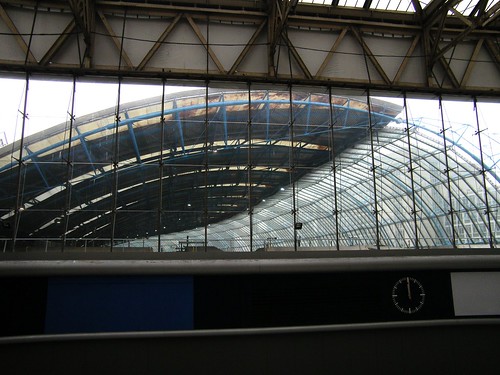
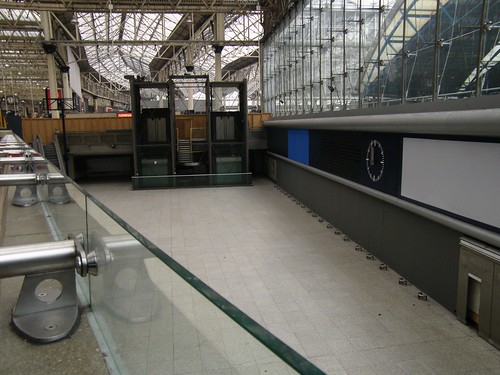
Waterloo International station was designed by Nicholas Grimshaw and won the RIBA Building of the Year award in 1994, when it opened to Channel Tunnel services. It had been finished the previous year but completion of the tunnel itself was delayed. It then remained in use until November 2007, when the service was transferred to a magnificent new terminus at St Pancras, where the station was extensively renovated in another prestigious scheme.
Since then, the four platforms have been unused and there are no plans for the space. This should not be happening. Surely someone could find at least an interim use such as a flea market or a sports or entertainment venue?
How would the high speed lines be paid for?
"Fast Forward" suggest that...
A variety of funding sources could be available to fund a high-speed line. The beneficiaries of HSR extend well beyond HSR users and include freight as well as passenger, the short-haul air sector as well as road users and rail passengers on the existing network too. In addition to direct Government funding other sources might include:
The second point is revealing and borne out by French experience. High speed rail will be competing for funds against other transport investment. We may end up with a wonderful high speed network and large tracts of the country deprived of any train services at all.
A variety of funding sources could be available to fund a high-speed line. The beneficiaries of HSR extend well beyond HSR users and include freight as well as passenger, the short-haul air sector as well as road users and rail passengers on the existing network too. In addition to direct Government funding other sources might include:
- Farebox revenue from HSR users;
- hypothecated charges on road or aviation users,
- businesses rates and environmental charges;
- capital grants from strategic beneficiaries such as airports;
- regional funding – but which is unlikely under current arrangements to stretch very far.
- There is also likely to be some scope to realise major property value uplifts in the vicinity of HSR stations and these could be used to defray some of the capital cost. The extent to which property gains will materialise is largely dependent on the availability of developable land at station locations as well as economic recovery of the property sector. It should be realised that the values are unlikely to be on the scale available to HS1, which was developed to both serve and exploit the Thames Gateway.
- For Government, funding levels will need to take into account investments and expenditures that can be foregone (for example upgrades or investments on the classic network and other transport modes and other regional regeneration projects) and reduced revenues on the adjacent classic network
The second point is revealing and borne out by French experience. High speed rail will be competing for funds against other transport investment. We may end up with a wonderful high speed network and large tracts of the country deprived of any train services at all.
Why does it take new high speed railways to achieve this?
"Fast Forward", the promotional book produced by Greengauge, argues that the key features of the HSR service would be...
Advance booking is surely something to be avoided as far as possible, but it is almost unavoidable when so much investment is tied up in astronomically expensive hardware. People like to be able to make decisions to travel, or not to travel plans, up to the last possible moment. Unexpected things crop up in peoples' lives, not least, in the course of the journey itself, which can cause unwanted stress. But the unpredictability of the individual's circumstances averages out over the population at large, so it is not difficult for an operator to predict what the traffic demand is likely to be at any particular time. As far as possible, therefore, the train service should be affordable and walk-on. The Eurostar model is not one to emulate.
- Modern easy booking systems, allowing passengers to book in advance, take advantage of frequent traveller programmes, print out their own tickets and plan their whole end-to-end journey effectively;
- Easy ways to access HSR, with dedicated platforms at modern stations, new interchanges with other modes of transport;
- High-levels of customer service at stations and on trains, with staff on hand at all times providing attention to the details that count;
- Sleek modern and clean new trains, with communication and entertainment facilities on board to make good use of travelling time;
- Dramatically reduced journey times compared with today, providing a competitive alternative to short-haul air travel.
- Express limited-stop rail services between Britain’s major towns and cities;
- Ultra-high levels of punctuality, beating delays on the congested road network.
- A consistent and readily-understandable pricing structure. In contrast to the national rail network, Eurostar has a memorable £59 price point for return journeys to Paris/Brussels, although a range of more flexible and more expensive fares are offered which help keep up average yields. An equivalent lowest promotional price point for domestic high-speed rail services could be £39 for a return trip – offering such fares, even if limited to less busy trains, will help ensure that HSR is affordable to all.
- Information and arrangements for before the journey and for onward travel to the ultimate destination. To reduce hassle and increase the ease of travel, reflecting the point that the rail trip is normally only one part of a longer journey and many users are not regular rail travellers.
- A service that runs 7 days a week, without weekend closures for engineering works. On Japan’s Shinkansen network, all engineering work is carried out at night, avoiding the need for any line closures in the daytime. Sunday is the busiest day of the week at Heathrow: an indicator that this is often chosen as a good day for longer distance trips; unfortunately, Sunday travel on today’s rail network can be a chancy affair.
- Modern standards of accessibility, including for the mobility-impaired. In part, this can be enhanced through excellent customer service, but building new infrastructure and trains provides the opportunity to provide from the start facilities that allow for easy access by all.
Advance booking is surely something to be avoided as far as possible, but it is almost unavoidable when so much investment is tied up in astronomically expensive hardware. People like to be able to make decisions to travel, or not to travel plans, up to the last possible moment. Unexpected things crop up in peoples' lives, not least, in the course of the journey itself, which can cause unwanted stress. But the unpredictability of the individual's circumstances averages out over the population at large, so it is not difficult for an operator to predict what the traffic demand is likely to be at any particular time. As far as possible, therefore, the train service should be affordable and walk-on. The Eurostar model is not one to emulate.
Beyond electrification
In an earlier post I suggested a core list of lines which ought to be in an electrification programme spread over twenty years of so. This leaves a residue of routes which it is unlikely will ever be electrified. This include for example
The current plan is that main line services will be operated with the hybrid trains on order from Hitachi, but this is a costly, wasteful and ineffective solution. The performance of the trains will be inferior to the present Inter-City 125 trains on non-electrified lines and the diesel power will be needed to supplement electric traction on the electrified sections of route.
Local services are at present operated by diesel multiple unit trains. At present, the stock dates either from the end of the British Rail period or is of more recent construction. Further purchase of DMUs is likely to end. The aim is that the spread of electrification and the introduction of new electric trains will allow the oldest DMUs to be withdrawn. But it is difficult to see how this will be possible given the limited size of the electrification programme.
There is a need to develop an alternative rolling stock strategy throughout the system, in which any stock can be operated flexibly with any other stock, using different types of traction units, including both prime movers in which the energy of the fuel is converted to mechanical power on the train itself, and under electric power. Such a unit is of course known as a locomotive.
- All lines beyond Glasgow, Stirling and Aberdeen
- All lines west of Exeter and Swansea
- All lines west of Chester
- Shrewsbury - Chester
- Everything not listed in my previous blog - electrification plans only scratch surface
The current plan is that main line services will be operated with the hybrid trains on order from Hitachi, but this is a costly, wasteful and ineffective solution. The performance of the trains will be inferior to the present Inter-City 125 trains on non-electrified lines and the diesel power will be needed to supplement electric traction on the electrified sections of route.
Local services are at present operated by diesel multiple unit trains. At present, the stock dates either from the end of the British Rail period or is of more recent construction. Further purchase of DMUs is likely to end. The aim is that the spread of electrification and the introduction of new electric trains will allow the oldest DMUs to be withdrawn. But it is difficult to see how this will be possible given the limited size of the electrification programme.
There is a need to develop an alternative rolling stock strategy throughout the system, in which any stock can be operated flexibly with any other stock, using different types of traction units, including both prime movers in which the energy of the fuel is converted to mechanical power on the train itself, and under electric power. Such a unit is of course known as a locomotive.
12 Jan 2010
Electrification plans only scratch surface
Britain has one of the lowest percentages of electrified line in Europe. It comes after Macedonia and before the Czech Republic. This is not necessarily a bad thing, because lines with light traffic should not be electrified, but some of the busiest lines in Britain are not, such as London to Bristol.
The latter is one of the routes to, which last summer, the government gave the go-ahead for electrification. The plan is for electrification of the lines from London to Oxford, Newbury, Bristol, Cardiff and Swansea, and between Liverpool and Manchester. But this only scratches the surface of what needs to be done. There is a long list of lines where electrification would fill in gaps and provide network benefits. These include (in no particular order of priority)
The latter is one of the routes to, which last summer, the government gave the go-ahead for electrification. The plan is for electrification of the lines from London to Oxford, Newbury, Bristol, Cardiff and Swansea, and between Liverpool and Manchester. But this only scratches the surface of what needs to be done. There is a long list of lines where electrification would fill in gaps and provide network benefits. These include (in no particular order of priority)
- Gospel Oak - Barking
- Ashford - Hastings
- Lewes - Hurst Green
- Reading - Basingstoke
- Basingstoke - Salisbury and possibly Yeovil Junction and Exeter
- Oxford - Birmingham
- Leamington - Coventry
- Marylebone - Banbury
- Amersham - Aylesbury
- Leeds - Skipton - Carlisle
- Manchester - Sheffield via Hope Valley
- Manchester - Blackburn - Burnley - Halifax - Leeds
- Manchester - Leeds
- Sheffield - Leeds
- Lincoln - Nottingham
- Bedford - Derby - Sheffield
- Matlock - Manchester
- Buxton - Stockport
- Leeds - York
- Bristol - Birmingham
- Birmingham - Shrewsbury
- Oxford - Bletchley - Bedford - Cambridge
- Edinburgy - Dundee - Aberdeen
- Northallerton - Middlesborough and Sunderland
- Eaglescliffe - Darlington and other main routes in Teeside
- Glasgow - Perth - Dundee
11 Jan 2010
Where rail investment ought to be going
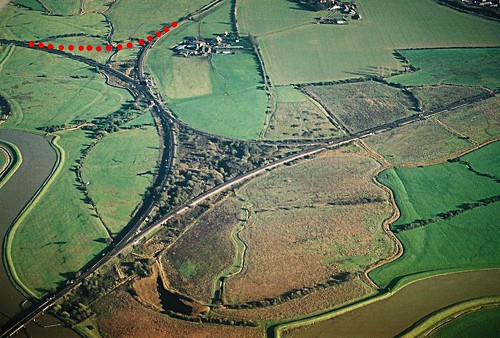
This is Ford Junction, Sussex. For want of the short section of route shown as a dotted red line, when the Brighton main line is closed, trains are diverted and have to run into Littlehampton and out again, reversing at the terminal. If this line was put in, the diverted trains would be at least 20 minutes quicker.
This is just one of a long list of railway improvements that could be made at relatively low cost in just this area. Others urgently needed or worth considering include
- Restoration of the direct line from Brighton to Hastings at Polegate.
- Doubling and possible electrification between Ashford and Hastings
- Reinstatement between Uckfield and Lewes
- Electrification between Hurst Green and Lewes
- Reinstatement between Shoreham and Horsham
- Reinstatement between Horsham and Guildford
- Reinstatement between Havant and Hayling Island
- Completion of quadruple track between Three Bridges and Brighton
- Completion of electrification between Tonbridge and Reading
- Construction of flyover at Redhill, with high level platforms and passenger interchange
- Reinstatement of double track to standard loading gauge between Hastings and Tunbridge Wells
- Reinstatement and possible electrification between Three Bridges and Tunbridge Wells
How a fast main line became an inter-urban stopping service
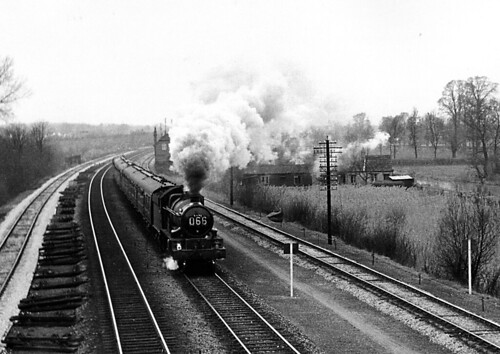
The Great Western main line was once famous for high speeds. Brunel built the original line between London and Bristol to the broad gauge with the aim of running the trains as fast as possible. In the nineteen-thirties, the Castle class locomotives (above) held the title for what was for a short while the fastest train in the world, with record-breaking runs between Swindon and London.
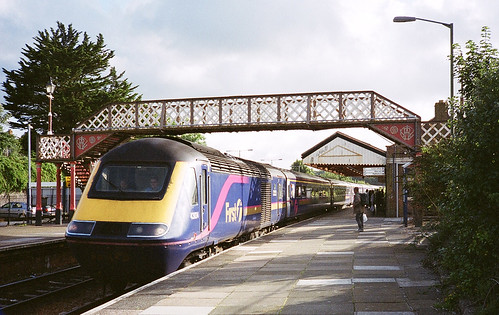
Then, in the 1970s, the Inter-City 125 (HST) trains (above) were introduced, maintaining the tradition of speed, with many trains running non-stop from London, with Bath as the only stop. What happened then? With the present timetable, trains stop at many places quite close together such as Slough, Reading, Didcot, Swindon, Chippenham and Bath. The population has spread out through Berkshire and Wiltshire, which has created a different pattern traffic of demand. The Great Western main line has become an inter-urban stopping service. These days, the HSTs are doing relatively little running at their top speed and when their engines were replaced recently, they would have benefitted from being fitted with lower gears to give better acceleration at the cost of a lower maximum speed.
The contemporary Great Western timetable reflects present day needs throughout the area where most people in Britain actually live. 80% of Britain's population lives south of a line drawn east-west through Leeds and west of a line drawn north-south through Bristol ie in one third of the land area. Within that area people and industry is dispersed to the point that it is quite difficult to serve by any form of public transport, least of all by high speed rail.
High speed is of little benefit in these conditions - what is needed is good acceleration and modestly priced walk-on services. Each increment in speed yields a successively smaller time saving because time equals distance divided by speed. In other words, higher speeds give diminishing returns. There are optimum operating speeds for rail in different conditions and in the UK it is probably around 160 kph.
Which leaves little place for high speed rail. The latter implies high fares, concessions only for fixed advance bookings, and rolling stock with as many seats as possible crammed in. Not the sort of thing that would tempt people out of their cars.
Speed - the point of diminishing returns
The typical inter city journey in Britain is between 100 and 150 miles. London - Birmingham is about 110 miles; Birmingham - Manchester about 90 miles; Manchester - Leeds 40 miles; Leeds - Newcastle about 90 miles; Newcastle - Edinburgh about 105 miles
100 miles at an average start-to-stop speed of 100 mph takes 1 hour. At 140 mph the journey time is 43 minutes - a saving of 17 minutes. What would people do with the 17 minutes if they did not spend it on the train, and what is the cost of saving this time, since energy consumption is more than double?
And that is only the station to station time. Realistically, the door to door journey time is more likely to be 1 hour 28 minutes instead of 1 hour 45 minutes, a useful amount admittedly, but it could equally well be saved by local transport improvements or better connectivity, which would be of benefit for everyone making local journeys.
That is not the entire story either. High speed rail services are not walk-on services, passengers will have to arrive longer in advance in order to be certain of not missing their bookings, so the journey could end up taking longer!
The sort of journey many people might want to make fairly often is Brighton to Oxford. This takes about three hours by crowded and uncomfortable train, including at least two changes. Thirty years ago there were two through trains a day taking 2 hours 35 minutes.
Connectivity counts
High speed rail is of limited value unless there is good connectivity, and good connectivity would transform the appeal of conventional train services without further vast expenditure on high speed railways.
Locally (East Sussex), I could list a whole string of rail improvements that could be implemented quickly and would be of real benefit over a significant area, achieving improvements in connectivity. No doubt anyone familiar with their patch could do the same. This would yield a long list of worthwhile projects, which high speed rail will force off the agenda.
100 miles at an average start-to-stop speed of 100 mph takes 1 hour. At 140 mph the journey time is 43 minutes - a saving of 17 minutes. What would people do with the 17 minutes if they did not spend it on the train, and what is the cost of saving this time, since energy consumption is more than double?
And that is only the station to station time. Realistically, the door to door journey time is more likely to be 1 hour 28 minutes instead of 1 hour 45 minutes, a useful amount admittedly, but it could equally well be saved by local transport improvements or better connectivity, which would be of benefit for everyone making local journeys.
That is not the entire story either. High speed rail services are not walk-on services, passengers will have to arrive longer in advance in order to be certain of not missing their bookings, so the journey could end up taking longer!
The sort of journey many people might want to make fairly often is Brighton to Oxford. This takes about three hours by crowded and uncomfortable train, including at least two changes. Thirty years ago there were two through trains a day taking 2 hours 35 minutes.
Connectivity counts
High speed rail is of limited value unless there is good connectivity, and good connectivity would transform the appeal of conventional train services without further vast expenditure on high speed railways.
Locally (East Sussex), I could list a whole string of rail improvements that could be implemented quickly and would be of real benefit over a significant area, achieving improvements in connectivity. No doubt anyone familiar with their patch could do the same. This would yield a long list of worthwhile projects, which high speed rail will force off the agenda.
9 Jan 2010
What rolling stock?
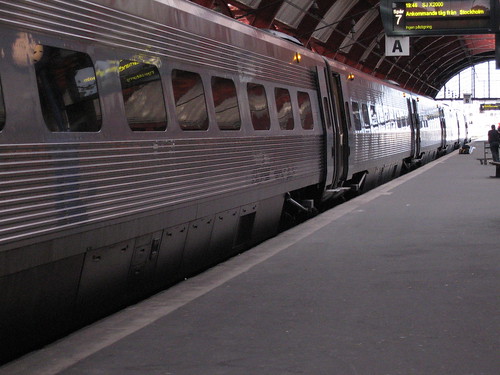
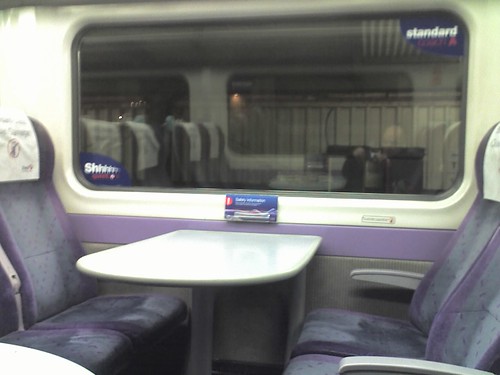
Sensibly designed stock for Britain's railways would look something like this. It would be locomotive hauled, like the vehicles in the blog masthead (BREL's International train), and it would be constructed of corrugated stainless steel, for strength, lightness and low maintenance, like the Swedish X2000 tilting train, above. It would have a bay dimension of 1.9 metres and most of the seats would be arranged in facing pairs on either side of a window, as in the Alstom Adelante train in the lower illustration. Not more than one-third of the seats would be arranged airline style, and they would have a spacing of 95 mm. There would be ample space for luggage, mostly between the backs of the seats, though additional luggage shelves would be needed for passengers sitting in airline-style seats since these have not luggage space between the seat backs.
All the seats would be corrrectly aligned to the windows to give an unobstructed view.
The case for high speed rail
The case for high speed rail in Britain is set out in this document, Fast Forward. It has been produced by Greengauge21, an industry consortium which describes itself as "a not-for-profit organisation which aims to research and develop the concept of a high speed rail network, and to promote its implementation as a national economic priority.
"Founded by Jim Steer, one of the country's leading transport sector specialists, Greengauge 21 has been established to progress the debate on High Speed Rail and to promote it in the public interest. The organisation has been conceived as an umbrella under which all those with an interest in supporting and promoting a High Speed Rail network can come together and openly and publicly debate the merits of alternative routes, priorities and technologies, alternative implementation strategies and the economic and environmental benefits for Britain."
Jim Steer was a founder and until 2002, when he became Strategic Director of the Strategic Rail Authority, managing director of the transport consultants Steer Davies Gleave. The present shape of Britain's railways owes much to the philosophy of transportation to which he adheres.
"Founded by Jim Steer, one of the country's leading transport sector specialists, Greengauge 21 has been established to progress the debate on High Speed Rail and to promote it in the public interest. The organisation has been conceived as an umbrella under which all those with an interest in supporting and promoting a High Speed Rail network can come together and openly and publicly debate the merits of alternative routes, priorities and technologies, alternative implementation strategies and the economic and environmental benefits for Britain."
Jim Steer was a founder and until 2002, when he became Strategic Director of the Strategic Rail Authority, managing director of the transport consultants Steer Davies Gleave. The present shape of Britain's railways owes much to the philosophy of transportation to which he adheres.
6 Jan 2010
Higher speeds and diminshing returns

The British government is preparing a report on the future of high speed rail in Britain. A firm proposal is expected in the spring. Enthusiasm is growing, as more and more people become familiar with travel on high speed lines on the continent. But Britain is not the continent and the British railway network is not tied in to the continental one except through the Channel Tunnel. The case against high speed rail in Britain is strong, and it needs to be put, because investment in high speed rail could turn out to be bad value for money, especially bearing in mind how else it could have been spent.
France, Germany and Spain, which have the best-developed high-speed systems, are large countries with cities far apart, separated by sparsely-populated countryside. Britain has a completely different pattern of settlement, with 80% of the population living in less than one-third of the land area, but relatively spread-out within that area, in low-density suburbs that are difficult to serve economically by any form of public transport.
For these reason, most people's preferred mode of travel is the private car. Public transport is used primarily for travel within the denser areas of the larger cities and conurbations. Most rail journeys in Britain are made within London and the South East
Rail remains important for inter-city travel but a typical inter-city journey in Britain is around 200km, perhaps even less. This is why high speed rail may not be a worthwhile investment.At a start-to-stop speed of 100kph, a 200 km journey will take 2 hours from end to end. Increase the speed to 150 kph and the journey time goes down to 80 minutes, a saving of 40 minutes. A further increase in speed to 200 kph takes the journey down to 1 hour, a saving of another 20 minutes. The next 50 kph increase in speed reduces the journey time to 48 minutes, a saving of just 12 minutes. (see diagram) Successive increases in speed yield diminishing savings of time.
And what about the costs?
And what about the costs?
The general rule is that energy consumed is proportional to the square of the speed; a train running at 200 kph uses twice the energy of one at 140 kph. But things are much worse than that. There is a set of critical speeds where the technology changes. At speeds of up to 40 kph, railways can run under what is known as a "Light Railway Order" with simplified signalling, etc. Most of the preserved museum railways operate under this rule. Special dispensations from the rules that apply to ordinary railways can be given to railways operating at up to about 90 kph.
The next break-point is 160 kph, when the railway is classified as a high speed line and must comply with EU rules for such lines, which add an entire additional layer of costs.
In addition to these critical speeds where the lines become subject to different regulations, there are other break-points due to technical requirements. 120 kph is about the maximum speed at which the ventilation of trains by means of opening windows is acceptable. At speeds of above about 160 kph, more efficient braking systems are needed, the suspension system has to be very much more complex and the track must be constructed to different standards, using heavier rails and other components. The situation changes again above 160 kph, when some form of continuous in-cab signalling such as the European Rail Traffic Management System (ERTMS) becomes essential. It is also the case that at higher speeds, wear and tear on both trains and track become much heavier due to the higher forces involved, proportional to the square of the speeds.
What the diagram seems to indicate is that for the sort of inter-city journeys that are typically made in Britain, it is worth constructing new railways and increasing train speeds up to about 160 kph, just below the point at which the lines become subject to EU regulations, but no more than that.
Geography of Britain wrong for high speed rail
80% of Britain's population live within one-third of the country's land area. If you draw a line around and area that includes Southampton, Bristol, Birmingham, Liverpool, Manchester, Leeds, Sheffield, London and Eastbourne, you have included 80% of Brtain's population. You have excluded most parts of the country with significant populations, the only substantial conurbations being Edinburgh/Glasgow and Tyne and Wear. This means that most inter city journeys are less than about 200km. High speed rail produces little worthwhile time savings at those sort of distances.
Within the most densely developed regions, a structure has built up since 1950 which can most concisely be described as sprawl, and it is difficult to service by any form of public transport. Until this changes, the car will be the preferred method of passenger transport. The main changes will be relatively marginal and achieve through the development of park and ride schemes, tramways, and congestion charging. Their main benefit will be to make the urban environment safer and pleasanter, especially for people when on foot. This is not a negligible gain, but it is not going to save the planet, if indeed the planet needs to be, or can be, saved.
Within the most densely developed regions, a structure has built up since 1950 which can most concisely be described as sprawl, and it is difficult to service by any form of public transport. Until this changes, the car will be the preferred method of passenger transport. The main changes will be relatively marginal and achieve through the development of park and ride schemes, tramways, and congestion charging. Their main benefit will be to make the urban environment safer and pleasanter, especially for people when on foot. This is not a negligible gain, but it is not going to save the planet, if indeed the planet needs to be, or can be, saved.
Subscribe to:
Comments (Atom)


